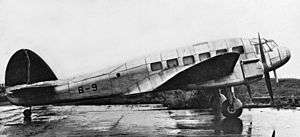Blackburn H.S.T.10
The Blackburn H.S.T.10 (sometimes known as the Blackburn B-9) was a 1930s British twin-engined commercial monoplane, designed and built by Blackburn Aircraft at Brough, East Yorkshire.[1]
| H.S.T.10 | |
|---|---|
 | |
| Blackburn HST.10 | |
| Role | 12-passenger commercial Monoplane |
| National origin | United Kingdom |
| Manufacturer | Blackburn Aircraft |
| Number built | 1 |
Design and development
The H.S.T.10 was a low-wing cantilever monoplane powered by two Napier Rapier VI engines. It had a retractable conventional landing gear with an enclosed cabin for two pilots and twelve passengers. It was fitted with a single-spar all-metal wing, known as the Duncanson wing, that had previously been tested on a Blackburn Segrave. The prototype used test serial B-9. In 1937, the project was abandoned, and B-9 was given to Loughborough College as an instructional airframe.[1]
Specifications
General characteristics
- Crew: 2
- Capacity: 12
- Length: 42 ft 0 in (12.8 m)
- Wingspan: 57 ft 4 in (17.5 m)
- Height: 12 ft 0 in (3.6 m)
- Wing area: 442 ft2 (41 m2)
- Gross weight: 8600 lb (3904 kg)
- Powerplant: 2 × Napier Rapier VI, 365 hp (272 kW) each
Performance
- Maximum speed: 204 mph (328 km/h)
- Service ceiling: 23800 ft (7259 m)
References
| Wikimedia Commons has media related to Blackburn H.S.T.10. |
- Notes
- Jackson 1974, pp. 217-218
- "To Cruise at 175 MPH". Flight: 1281. 29 November 1934.
- Sources
- Jackson, A.J. (1973). British Civil Aircraft since 1919 Volume 1. London: Putnam. ISBN 0-370-10006-9.
This article is issued from Wikipedia. The text is licensed under Creative Commons - Attribution - Sharealike. Additional terms may apply for the media files.